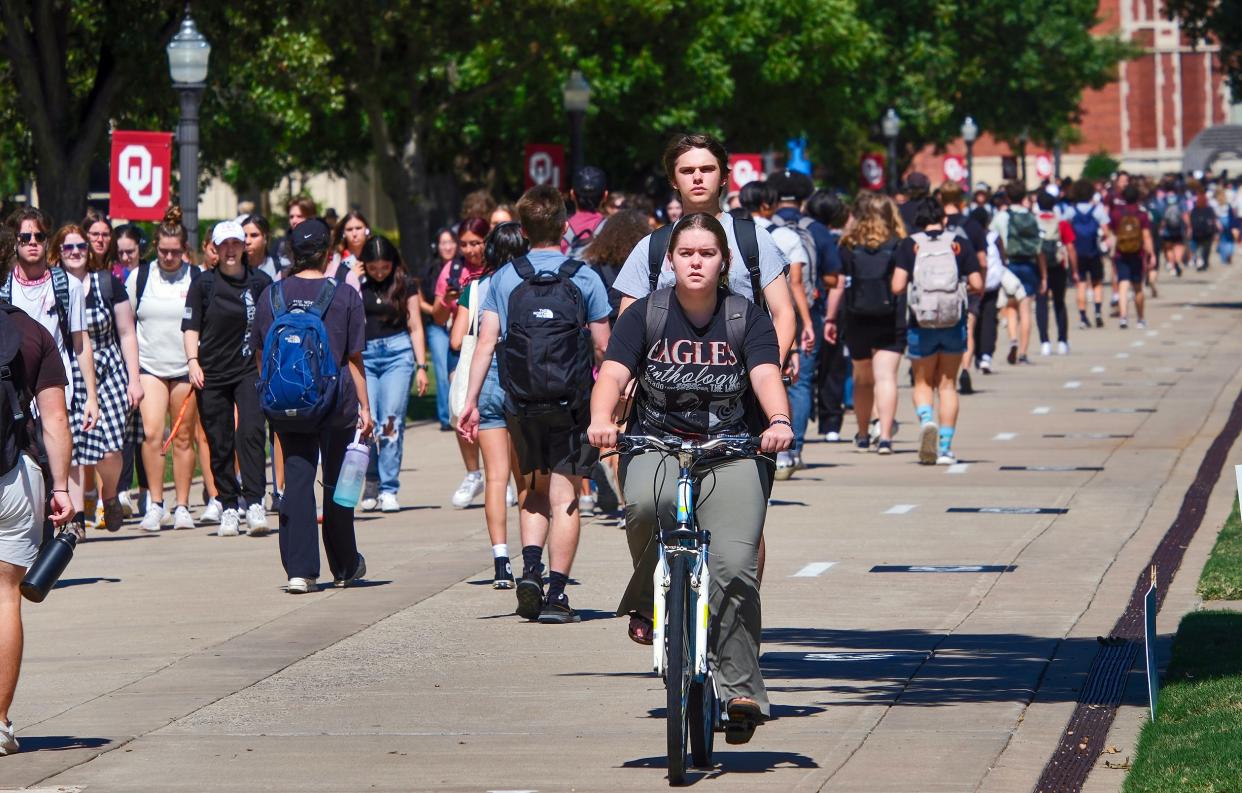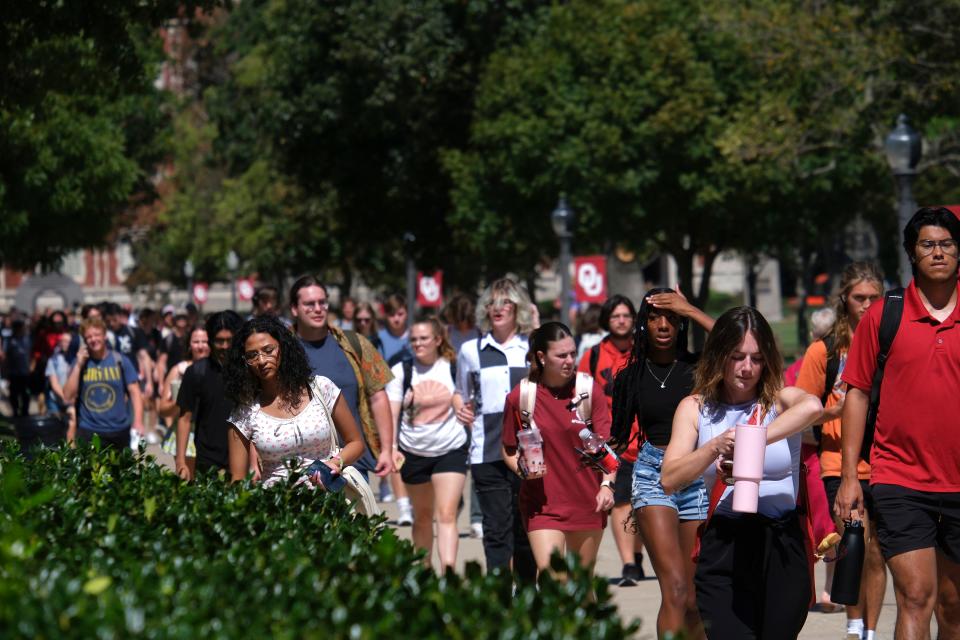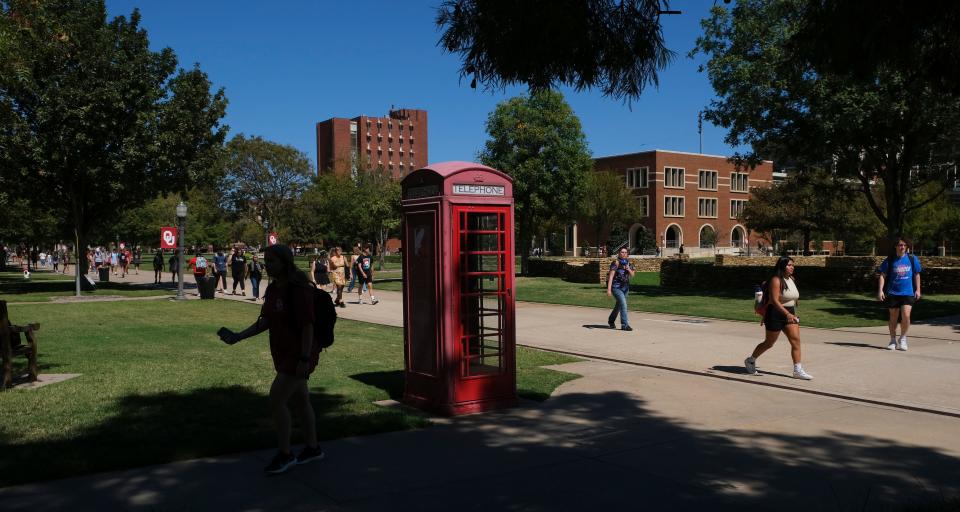Colleges are struggling to recruit Native students. What will ban on race in admissions mean?

Three months after the U.S. Supreme Court banned colleges from weighing race in admissions, it remains unclear how the ruling will affect Native American students.
But the first big test is now underway as high school seniors start filling out and sending in their applications.
College officials already were struggling to recruit and retain Native Americans, who are almost always underrepresented on campuses built across their tribal homelands. Less than one-tenth of 1% of all U.S. undergrads are Native, a share that is losing ground as more students forgo college altogether after the pandemic.
Advocates working to turn the tide on those declines see a way for colleges to pivot after the Supreme Court ban. They believe schools could consider whether a student belongs to a tribal nation, a political identity rooted in treaties.
“This is not about race for tribal nations,” said Ben Barnes, the chief of the Shawnee Tribe in northeast Oklahoma. “We are citizens. We are citizens of existing nations. We preexisted before the United States.”
Do universities consider tribal citizenship as part of the admission process?
Treaties between the U.S. government and those tribal nations promised education for tribal citizens in exchange for ceding millions of acres of land. But the federal government has long fallen short of delivering equitable educational opportunities for Native children.
Colleges, on the other hand, largely benefited from the removal of tribal nations from their homelands, Barnes noted. Many stand on Native land. Land grant universities were funded by the sale of Native land. And several universities started as boarding schools to assimilate Native children.
Yet, amid a nationwide debate over what schools teach about the lasting harms of systemic discrimination, college administrators do not appear to be moving quickly to incorporate tribal citizenship into admissions decisions.

The USA TODAY Network asked 25 universities whether they sought information from prospective students about tribal identities and weighed those answers as part of the admissions process. Only six directly answered the questions, and none said tribal citizenship was among the many factors they considered, which some states set by law.
Harvard University, one of two schools at the center of the Supreme Court ruling, declined to say anything at all. Last fall, the Ivy League school reported 46 Native students in its student body of 25,266. The school apologized later that semester for its “complicity in the objectification of Native peoples,” acknowledging its museum had held on for decades to the hair clippings of more than 700 Native American children forced to attend government-run boarding schools.
“The message that that sends is that even if change is starting to happen, that at one time, this wasn’t the place for you or your ancestors,” said Tesia Zientek, who leads the National Indian Education Association and the Oklahoma Council for Indian Education.
Federal investigation into boarding schools continues
The fraught history of how the educational system has treated Native students has come to widespread light as part of a deepening federal investigation into hundreds of boarding schools similar to the one attended by students whose hair Harvard kept.
The United States acknowledged in a report last year the schools had little educational purpose and instead were meant to prepare Native children for manual labor and erase connections to tribal nations. Researchers believe hundreds or thousands of children died at the schools.
That history makes efforts to increase opportunities for Native students all the more pressing today, Zientek said.
More: What we know about the investigation into Native American boarding schools
She worries the Supreme Court ban could slow the efforts of Harvard and other schools to create pathways for Native students, especially if administrators do not grasp what tribal citizenship means.
If someone is a tribal citizen, that means a sovereign government with a unique political relationship with the United States recognizes them as one, said Zientek, who belongs to the Citizen Potawatomi Nation in Oklahoma.
The Supreme Court has recognized the political nature of tribal citizenship in rulings as recently as this summer, when the court upheld a federal child welfare law that applies to tribal citizens.

“It's not a racial identity, it’s a political identity,” Zientek said. “However, that’s how it should be understood, but it’s not understood that way (at universities) across the board.”
The confusion surrounding tribal citizenship has become particularly charged in Oklahoma, as Gov. Kevin Stitt often uses the term interchangeably to describe a person’s race. Stitt himself is a citizen of the Cherokee Nation. But he objects to the expansion of tribal government authority over tribal citizens, saying he does not want to divide the state by race.
More: Amid legal uncertainty, Oklahoma's governor ramps up rhetoric against tribal governments
How Oklahoma universities responded
None of four Oklahoma universities surveyed for this story said they considered a student’s tribal identity in admissions decisions or plan to begin doing so. The University of Tulsa, a private university that started as a Presbyterian boarding school for Native American girls, did not respond to the questions.
The University of Oklahoma, a school whose Sooner mascot stems from the rush by white settlers to claim land the United States had promised to tribal nations, said it asks prospective students whether they are tribal citizens “for data collecting purposes only.”
In a statement, the university said it does not factor tribal citizenship into its admissions process because of a statewide ban on affirmative action approved by voters in 2012. The law prohibits public agencies and schools from “preferential treatment or discrimination based on race, color, sex, ethnicity or national origin.”
OU officials declined to say how they interpreted the ban to apply to tribal citizenship.
Poll: Oklahoma voters want state and tribes to work together amid political tensions
The school told federal regulators it accepted 73% of students who applied for admission last fall, and 3% of students enrolled were Native. It also reported 10% of students identified as two or more races, a broad category that could also include some Native American students.
The statistics underscore the complex intersection between tribal citizenship and racial identity, and how widely that can vary among students, said Zientek, who works as a program director for the American Indian Science and Engineering Society. The New Mexico-based group helps students pursue science and technology careers.
Some Native students may not meet tribal enrollment criteria for a variety reasons, or some may belong to tribes that are not formally recognized by the federal government, which is especially true in California, said Joely Proudfit, who teaches Native studies and directs the California Indian Culture and Sovereignty Center at California State University San Marcos.
Considering whether a student is a tribal citizen is a practical approach for colleges to recognize the sovereignty of tribal nations and their unique relationship with the U.S. government, Proudfit said.
“However, it is crucial to acknowledge the diversity among Native communities,” said Proudfit, who is Luiseño/Payómkawichum and Tongva.
How Oklahoma universities compare to other schools in the nation
California became the first state to ban race conscious admissions practices, often referred to as affirmative action, in 1996. One study later found the number of Native students attending some California public universities fell soon after the ban took effect from double digits to single digits.
“The ban has made it more difficult to consider the unique experiences and backgrounds of Native students during the admissions process,” Proudfit said.
But proponents of such bans have contended they do not create more barriers. In a brief filed with the Supreme Court, lawyers for the state of Oklahoma said OU recorded no apparent drops in enrollment tied to the state’s ban.
The state’s flagship university already had moved away from considering race in admissions in anticipation of the ban. The school adopted a holistic approach that officials said they still use today.
“The University of Oklahoma reviews freshman applications utilizing a holistic admissions process, which considers several factors that predict academic success, including academic rigor and performance, engagement, essay and letters of recommendation,” the university said in a statement.
Oklahoma State University would not say if it asks about or considers tribal citizenship in admissions decisions. A spokesperson emailed a two-sentence statement, which said in part that the school “provides tremendous opportunities for students from all walks of life and backgrounds, and race is not a factor considered in admissions.”
Five percent of undergrads at OSU’s main campus are Native American, the largest share reported by any school surveyed for this story. It admits 71% of applicants.
More: What to know about Oklahoma's newest tribal compact dispute
The University of Pennsylvania sits on the other end of the spectrum. A private Ivy League school in Philadelphia, its acceptance rate is 7%. Of the 2,409 students who enrolled in undergraduate classes last fall, three identified as American Indian or Alaska Native.
Penn declined to answer any questions about admissions, but said it awarded scholarships based solely on need and planned to host a program for Native high school students next year.
“Our commitment to creating a diverse community is central to the educational experience at Penn,” university spokesman Ron Ozio said in a statement.
Schools making an effort to change their practices
The Supreme Court ruling has raised questions for Native students considering college about where they would be welcome, said Cheryl Crazy Bull, president and chief executive of the American Indian College Fund. The Utah-based nonprofit offers scholarships as a way to increase access for Native Americans in higher education.
“We’re looking at what are institutions doing to expand their recruiting outreach and try to create a greater sense among Native students that they would be welcome and that there are opportunities,” said Crazy Bull, a member of the Sicangu Lakota Nation in South Dakota.
More colleges also are starting to reckon with how they benefited from the taking of Native land and how to help people who were harmed by those same policies, Crazy Bull said.
State lawmakers also are making changes. Kansas passed a law this year to allow students whose tribes have historical connections to the state to pay in-state tuition rates. Public university systems in neighboring Iowa and Nebraska have similar policies, as do some public schools in Arizona and Oregon and all in Washington.
The University of Utah launched a scholarship fund earlier this year for students from federally recognized tribes with ties to the state. The University of California system began waiving tuition and fees entirely for tribal citizens who reside in the state. UC officials said the tuition waivers, which started last fall, do not violate the state’s affirmative action ban, because tribal citizenship is a political classification. Officials described it as an effort to increase the representation of Native students on campuses.
One UC school, UCLA, is more direct about what it views as its obligation to Native people. “Because UCLA is an institution that benefited from the dispossession of Native people from these lands, it bears a moral responsibility to the peoples impacted,” says a page on the university’s website. “It is important for the UCLA community to recognize that their presence and the university’s existence are a result of Native peoples’ displacement and land dispossession.”
Zientek said she recently met with a Citizen Potawatomi student from northern California to discuss his college plans and showed him the opportunities available at University of California schools.
“That was a huge relief for him,” she said, “and he kept asking me, ‘Are you sure?’”
Molly Young covers Indigenous affairs. Reach her at mollyyoung@gannett.com or 405-347-3534.
This article originally appeared on Oklahoman: Colleges can still consider tribal citizenship in admissions, some say

